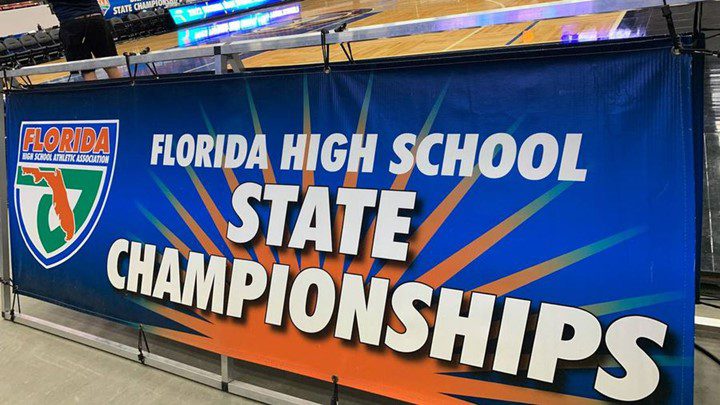
DeSantis would get this nearly unprecedented new power under Florida bill
A bill to give the governor authority over Florida high school sports has only one peer: Delaware.
Tampa Bay Times | By Matt Baker | Updated March 30, 2023
A proposal in the Florida Legislature to give Gov. Ron DeSantis more power over high school sports is nearly unprecedented. The Tampa Bay Times could find only one state that currently has similar executive authority over its primary prep athletics association: Delaware.
Though groups such as the Florida High School Athletic Association (FHSAA) and its board of directors are easy to overlook, their policies and procedures help shape students’ high school careers. That means a potential overhaul to Florida’s governing body is worth exploring.
What is the FHSAA?
The Florida High School Athletic Association is a century-old nonprofit organization that regulates sports at almost every high school in the state. It is overseen by a 16-person board of directors: 12 members elected by schools, three appointed by the education commissioner, and the commissioner (or his/her designee).
What changes are proposed?
The board would shrink to nine members and be chosen very differently under HB 225 and SB 308. Eight members would be appointed by the governor, with confirmation by the Senate, and the ninth would be the education commissioner.
The proposal comes after the association board chose not to include mandatory questions about students’ menstrual cycles in paperwork given to schools for player participation. It also comes as DeSantis gains or exerts more executive power, from removing and replacing the Hillsborough County state attorney and school board members to controlling Walt Disney World’s government services.
Are prep sports regulated similarly elsewhere?
Every state has an organization like the Florida High School Athletic Association, a governing body that is a member of the National Federation of State High School Associations, which in turn sets many of the on-field rules. But after reviewing the handbook and bylaws of every public state association like Florida’s, the Times found only three states that allow the governor to make a direct appointment to their board: Delaware, Kansas and Montana.
What happened in Delaware?
Legislators there began looking at the state’s association around 2001. Some of their concerns aren’t applicable to Florida. The News Journal newspaper of Wilmington, Delaware, wrote that the association had a “rocky relationship” with a wrestling tournament and a prestigious basketball showcase. But state lawmakers also cited a lack of public oversight, a point that Rep. Fred Hawkins (R-St. Cloud) has made in Florida’s legislative push.
In 2002, Delaware replaced its governing body with a new one, the Delaware Interscholastic Athletic Association, that fell under the control of the state Department of Education. The change also gave the governor authority to reshape its board. The state’s current law says that 21 of the board’s 22 voting members are directly appointed by the governor “with the advice and consent of the Senate.” The lone exception is the secretary of the state’s Department of Education (or his/her designee); the secretary is also appointed by the governor.
What about Kansas and Montana?
The governors’ roles are more restrained in those states.
Of the seven members on the Montana High School Association’s executive board, only one, a layperson, is appointed by the governor. Four are administrators elected by the schools, one is elected by the state’s school boards association, and the other is a layperson appointed by the state’s education superintendent.
The Kansas State High School Activities Association has two boards. Only four of the 60-plus members of its legislative body are picked by the governor. Two governor appointees are among the 12 members of the executive board that enforces and administers the association’s rules.
Does the governor have input in other states?
Yes, indirectly. Some boards include or have members chosen by the state’s education head, usually an appointee of the governor. But the vast majority of boards are elected by that group’s member schools.
What about the states most similar to Florida?
Florida, Texas, California and Georgia are regarded as the four heavyweights in high school football. Each one has a different governing structure.
Texas’ state executive committee is chosen by the Texas Education Agency’s commissioner, a governor appointee. But the legislative arm of the activities association is a 32-person council. It has 24 superintendents (one per basketball region) who are elected by their peers and eight members selected by its chairperson.
Members of California’s federated council and executive committee are elected by an area’s schools or related organizations, such as state associations for coaches or school boards. There’s also one representative from the state Department of Education.
In Georgia, all trustees are either elected or appointed by their peers. Spots are allocated by class size, with two at-large seats reserved for private school representatives and two for women.
Is Florida considering other notables changes?
The bills would eliminate a provision that one board member be chosen “to balance the board for diversity or state population trends, or both.” At least 24 states require or encourage gender, racial and/or ethnic diversity on their boards. Those include Texas, California, Kansas, Michigan, Pennsylvania and Ohio.
What’s next?
HB 225 has been received by the Senate after passing the House 80-29 this month. SB 308 was on the calendar for the Senate Rules Committee’s meeting Thursday. The bills’ differences must be resolved and passed by both chambers before going to DeSantis’ desk.





